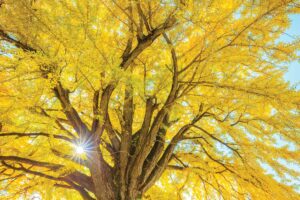Hold on to your hats! It is windy here in Illinois. Wind can be destructive to our homes and landscapes and make being outside miserable. This is why many Illinoisans plant windbreaks around their homes to keep that biting wind from causing a drafty house, prevent drifting snow, and make being outside tolerable.
Unfortunately, not all goes as planned with windbreaks. Some problems can be avoided with proper planning and choosing plant species suited to your location.
Space out your plants. Planting trees too close may be the biggest problem with windbreaks. Homeowners need to account for the mature size of the trees when designing the windbreak. Trees planted too close, grow and shade out lower limbs, which eventually fall off. Without lower limbs, the windbreak is not functional. With proper spacing, plants can reach their full size at maturity with a full canopy of wind-blocking foliage.
At planting time, be sure to remove the rootball wrapping. Often windbreak trees are larger and come as balled-and-burlapped plants. The burlap and wire cage helps keep the rootball intact during transportation and carrying the tree to the planting hole. When ready to plant, remove the wrapping so it is not a barrier to the root system.
Determining the proper planting depth can be tricky. At the time of purchase, there is usually too much soil on top of the rootball. Carefully remove that soil until you encounter the first structural root or root flare. Cut off any circling roots while you’re at it. The root flare should be at the soil surface. Also, be sure mulch and other materials are not piled up against the trunk of your newly planted trees.
Windbreaks don’t have to be uniform to be effective. Most consist of a single row of identical evergreens but be sure to mix up the species in your wind break. A common problem is when a plant disease specific to that species makes its way through the windbreak. A diverse windbreak is more resistant to pest and disease attacks and provides higher wildlife value.
Some of the best windbreaks I have observed have a diversity of evergreens, deciduous shade trees, small trees and shrubs. If you have the space, consider having multiple rows of different types of plants. This boosts the diversity of your planting to make it more resilient to environmental stresses. Each species has its own set of growing requirements, which your site may or may not provide. A more diverse selection of species helps to ensure your planting has suitable species for the site conditions.
Ideally, a windbreak will allow for some airflow to uniformly disperse snow and create a larger envelope of protection downwind. If tree spacing seems too far apart initially, consider planting trees closer together with plans to thin out.
It may be tempting to plan your windbreak at the field edge but allow space between the windbreak and adjacent agricultural fields. Many windbreaks are next to massive corn or soybean fields which are sprayed with herbicides. Leave a 30-foot buffer between the trees and farm field. In addition, farmers often need room for access with large equipment. A mowed grass buffer between your trees and agricultural production areas keeps your plants out of harm’s way.
There are many considerations when it comes to windbreaks. How tall should the tree be or how far out should it extend? What species work best? Check out the Good Growing blog for more resources on designing windbreaks at go.Illinois.edu/GoodGrowing.
Photo: Trees planted in windbreaks provide protection from the windy conditions often present in Illinois. While these plantings typically include evergreen species for year-round protection, a diversity of species is recommended to ensure your windbreak will thrive. Photo courtesy of Ryan Pankau, Illinois Extension










